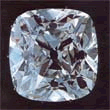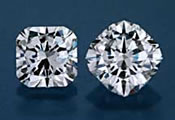 The Regent Cut™ diamond shape was born at the Atlass Group in Antwerp, Belgium. A joint venture with Horowitz & Atlass, New York City brings the Regent Cut™ to the U.S. market.
The Regent Cut™ diamond shape was born at the Atlass Group in Antwerp, Belgium. A joint venture with Horowitz & Atlass, New York City brings the Regent Cut™ to the U.S. market.
The Regent Cut™ took more than a year to develop after a customer asked whether the hearts-and-arrows effect achieved in some round diamonds could be shown in a square one. “Rounds are the benchmarks of brilliance,” says Cary Horowitz of Horowitz and Atlass. “But the Regent Cut™, seen on a BrillianceScope™ is equally or more brilliant in some cases because of precision cutting.” The 66-facet Regent Cut™ is based in part on the Regent Diamond, part of the French Crown Jewels that history texts have long declared the world’s most perfectly cut diamond. There are 41 facets on the crown and 25 facets on the pavilion of the Regent Cut™.
The story of the Regent cut diamond began with two young men who first met in the 1970’s. They shared a passion for diamonds. Years later, their paths crossed professionally as they sought together to solve a problem, a problem many before had sought to solve, but failed.
 The challenge was to create a square outline diamond with the brilliance and beauty of an ideal cut round. At a meeting in Basel, the world’s most prestigious jewelry trade fair, in 2001 both realized they had each had requests from Europe, Japan and USA for a better performing square diamond. They resolved to work together to design and patent a new stone. They also “upped the ante”; their new cut should also be a Hearts & Arrows.
The challenge was to create a square outline diamond with the brilliance and beauty of an ideal cut round. At a meeting in Basel, the world’s most prestigious jewelry trade fair, in 2001 both realized they had each had requests from Europe, Japan and USA for a better performing square diamond. They resolved to work together to design and patent a new stone. They also “upped the ante”; their new cut should also be a Hearts & Arrows.
Romain began the demanding and expensive process of cutting test diamonds. Firstly the process is demanding of the highest cutting skills because diamond faceting tools have settings or “clicks” to automatically align each facet. A round brilliant has 8 or 16 pre-set positions in the tang which holds the diamond on the polishing wheel, ensuring each facet is perfectly aligned. When cutting exacting new styles, with hearts and arrows symmetry, the cutter must make a decision. Have engineers design and make specific tools, or to trust a gifted cutter to wing it free hand. Secondly, the process is expensive. Hundreds of experimental diamonds can not be sold, for fear of industrial espionage. Secrecy is of the utmost importance right through to the lodgment of patents.
Table sizes for Regent Cut diamonds range from 60 to 72 percent. Total depth range is roughly 70 percent. Regent Cut diamonds are inscribed with their brand name and a Gemological Institute of America (GIA) certification number. Personal inscriptions can be engraved on the other two sides of the girdle of Regent Cut diamonds.
The Queen of Hearts™
 Horowitz and Atlass also developed the Queen of Hearts cut, which has a larger table facet and a more squarish outline. “It’s a great alternative for customers who like princess cuts but want something a bit different,” says Horowitz. “Historically, fancy cuts were developed as a way for diamantaires to make the best use of difficult rough, to get more yield (finished carat weight percent of rough carat weight). That’s still valid, but not as critical now. Yield takes a back seat to beauty.”
Horowitz and Atlass also developed the Queen of Hearts cut, which has a larger table facet and a more squarish outline. “It’s a great alternative for customers who like princess cuts but want something a bit different,” says Horowitz. “Historically, fancy cuts were developed as a way for diamantaires to make the best use of difficult rough, to get more yield (finished carat weight percent of rough carat weight). That’s still valid, but not as critical now. Yield takes a back seat to beauty.”
We are not able to sell the Regent Cut or the Queen of Hearts cut at the present time. If you are looking for a gorgeous square cushion cut diamond, give us a call and we will find the best diamonds available on the wholesale market meeting your requirements.
